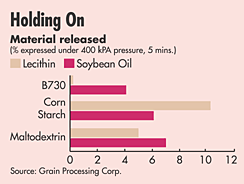
No Lumps
Inscosity™ Modified Food Starch from Grain Processing, Muscatine, Iowa, contributes to the body and appearance of gravies, sauces, salad dressings, dips, glazes and puddings. It imparts viscosity with a smooth surface, good clarity and sheen. The starch has a bland flavor that does not alter the product. Usage levels range from 5-25%, depending upon the dry mix formulation; the levels range from about 0.5-5% in the finished, hydrated formulation. It is effective in products with a mildly acidic to neutral pH.“The starch granule maintains its integrity in manufacturing,” explains Celeste Sullivan, senior applications scientist, and developer of the starch. “It is not agglomerated, but is designed to disperse easily in minimal diluents. It overcomes the lumping problem that occurs when a system hydrates unevenly.”
The starch also extends the solids levels of ingredients like tomato or fruit powders. In salad dressings, the product can be used in combination with gums to build texture and stability. It is freeze-thaw stable and maintains its integrity without syneresis on the steam table. Some food processors may wish to use the starch in their manufacturing to eliminate the variability of the cook-up process and to save a cooking step.
A Carrier for Sticky Ingredients
Some oily or sticky ingredients like oleoresins, chocolate, peanut butter, honey, essential oils, propylene glycol and lecithin, are easier to handle if plated onto carriers. For this purpose, manufacturers can use Pure-Dent® B730 modified food starch, which will not contribute unwanted functionality in the finished product.“The corn starch granule is modified to have more surface area,” says Mike Kramer, laboratory supervisor, technical services. “The starch is not pre-gelatinized, so the granule is still present. It is water insoluble, and it can absorb both oily and water-based ingredients.” The amount of material that can be plated onto the starch is about a 50% load. It can carry about 1½ times the load of some other carriers such as maltodextrin, sucrose or salt.
Plating can be done on various types of mixers. Spraying it onto a fluidized bed is recommended. Ribbon mixers or other conventional mixers also are effective.
Used mostly for in-process goods, the ingredients plated onto this starch are easier to handle and weigh more accurately. They can be blended or dispersed into mixtures evenly and there is a reduction in ingredients sticking to containers, thereby increasing yield.

For more information on Inscosity Modified Food Starch:
Celeste Sullivan at 563-264-4480
Celeste_Sullivan@grainprocessing.com
For more information on Pure-Dent B730:
Mike Kramer at 563-264-4423
Mike_Kramer@grainprocessing.com
www.grainprocessing.com
Grain Processing Corp. Write in 217